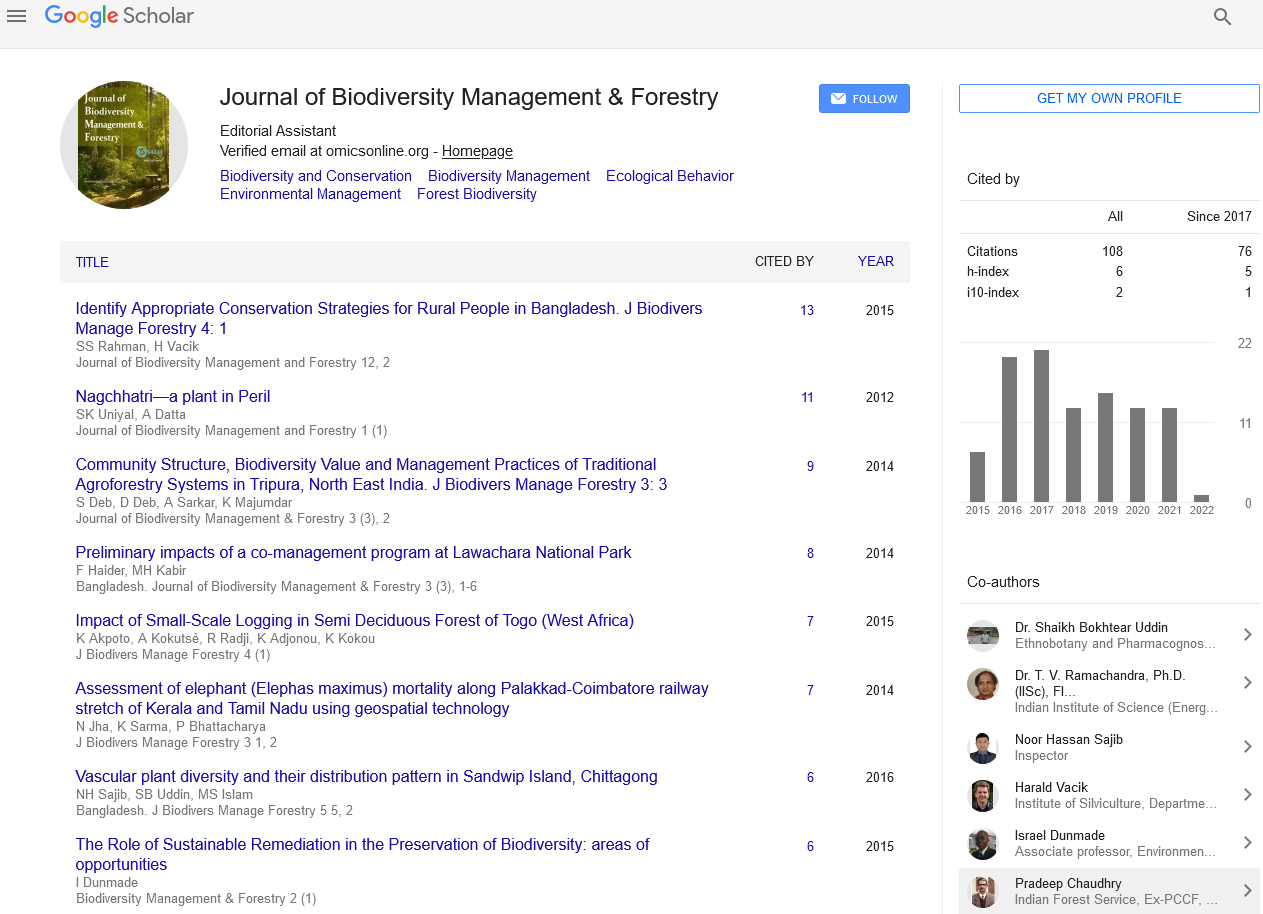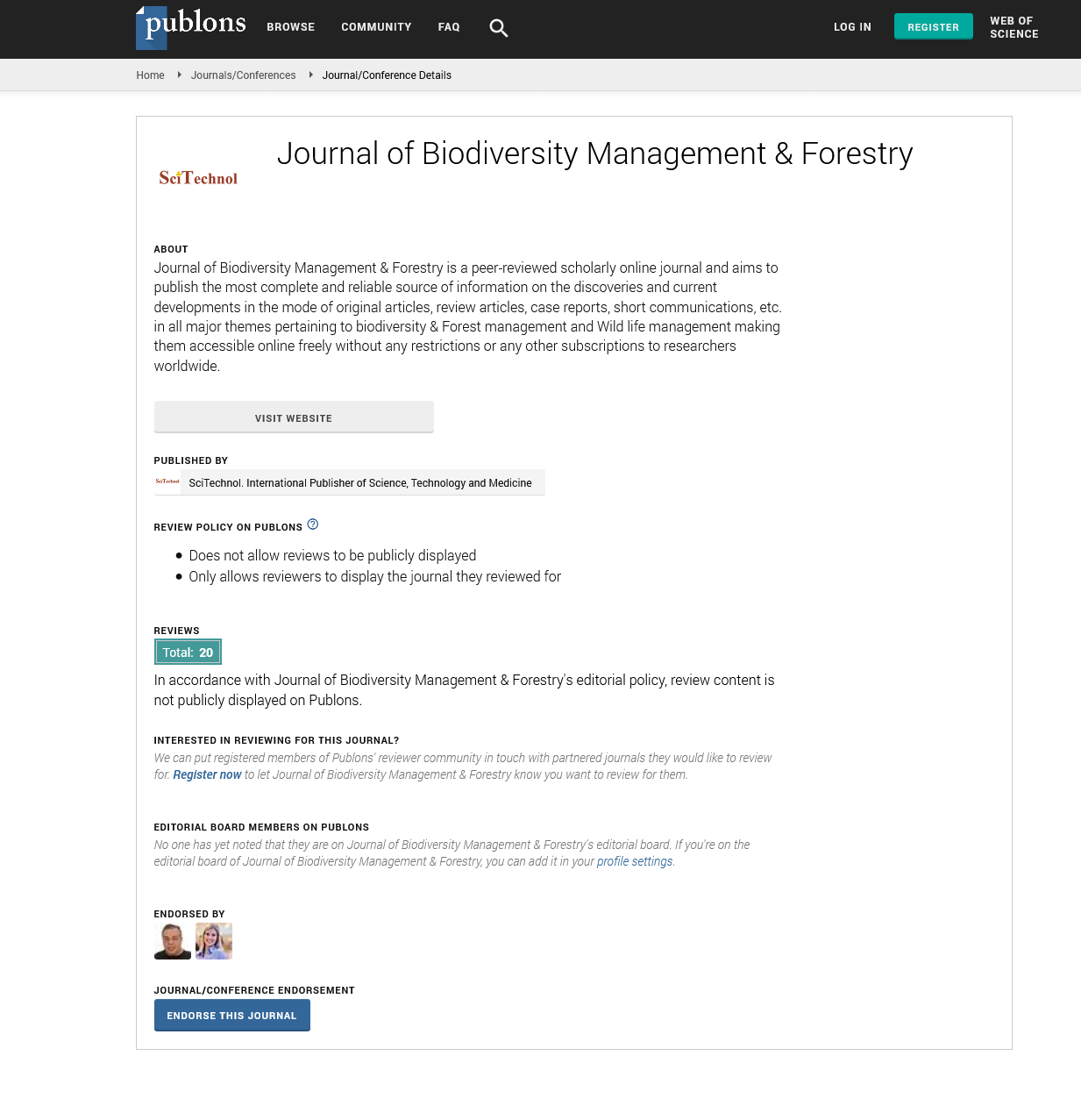Opinion Article, J Biodivers Manage Forestry Vol: 13 Issue: 4
Innovative Techniques for Forest Resource Optimization
Zhang Spronsen*
1Department of Forest Ecology, Vrije University Amsterdam, Amsterdam, The Netherlands
*Corresponding Author: Zhang Spronsen,
Department of Forest Ecology, Vrije University Amsterdam, Amsterdam, The
Netherlands
E-mail: zhangspronsen@163.com
Received date: 25 November, 2024, Manuscript No. JBMF-24-154573;
Editor assigned date: 27 November, 2024, PreQC No. JBMF-24-154573 (PQ);
Reviewed date: 11 December, 2024, QC No. JBMF-24-154573;
Revised date: 19 December, 2024, Manuscript No. JBMF-24-154573 (R);
Published date: 27 December, 2024, DOI: 10.4172/jbmf 2327-4417.1000070.
Citation: Spronsen Z (2024) Innovative Techniques for Forest Resource Optimization. J Biodivers Manage Forestry 13:4.
Description
Forest resource optimization refers to the strategic and sustainable management of forest resources, including timber, non-timber products and ecosystem services, to maximize their benefits while maintaining ecological balance. The increasing pressure on forests due to growing populations, climate change and industrialization has made it evaluative to employ innovative techniques that optimize forest resource use without compromising the health of the forest ecosystem. These techniques encompass a range of approaches, from advanced technologies to new management practices, which collectively aim to enhance the productivity, sustainability and flexibility of forests.
Precision forestry involves the use of advanced technologies such as remote sensing, drones and Geographic Information Systems (GIS) to monitor forest conditions and manage resources more efficiently. By collecting real-time data on forest health, growth patterns and tree density, forest managers can make informed decisions on resource extraction, regeneration and conservation. This approach not only improves the efficiency of forest management operations but also ensures that interventions are precise, reducing waste and reducing environmental impact. Agroforestry integrates trees and shrubs into agricultural systems, creating mutually beneficial relationships between crops, livestock and forest resources. This technique not only improves the productivity of agricultural landscapes but also enhances forest resource optimization by increasing biodiversity, improving soil health and reducing the need for external inputs like fertilizers and pesticides. Agroforestry systems can optimize forest resources by diversifying the types of products obtained from the land, such as fruits, nuts, timber and medicinal plants, while also promoting sustainable land use practices.
In agroforestry systems, trees provide shade and wind protection for crops, which can improve agricultural yields and resilience to climate change. At the same time, agroforestry practices can help conserve soil moisture, prevent soil erosion and enhance carbon sequestration, benefiting both the agricultural and forestry sectors. This approach allows for better use of available land and promotes sustainable land management. Sustainable forest management relies heavily on the adoption of certification schemes such as the Forest Stewardship Council (FSC) or Programme for the Endorsement of Forest Certification (PEFC). These certification programs ensure that forest resources are managed responsibly, with a focus on maintaining ecological integrity, respecting local communities' rights and ensuring long-term economic viability. Innovative harvesting practices, including selective logging, Reduced Impact Logging (RIL) and continuous cover forestry, are integral to these certification systems. Instead of clear-cutting entire forest areas, these methods allow for the selective removal of trees, ensuring that the forest canopy is preserved and regeneration processes are not disrupted. Reduced impact logging minimizes damage to surrounding vegetation, reducing soil compaction and preventing erosion. By optimizing timber extraction techniques, these practices help maintain forest biodiversity and ecosystem services, while also ensuring the availability of forest resources for future generations.
By quantifying the value of ecosystem services, such as clean air, water filtration and recreational opportunities, forest managers and policymakers can better understand the full range of benefits that forests provide. This helps in optimizing resource use, ensuring that forests are managed in a way that maximizes both ecological and economic returns. Ecosystem services valuation also plays a evaluative role in the development of Payment for Ecosystem Services (PES) programs, where stakeholders are compensated for their role in maintaining or restoring forest ecosystems. Innovative techniques for forest resource optimization offer a promising path toward more sustainable and efficient forest management. By combining advanced technologies, ecosystem-based management practices and economic valuation of ecosystem services, these approaches can help balance the demands for forest resources with the need to preserve forest ecosystems. As forests continue to face numerous threats, the adoption of innovative techniques will be essential for ensuring their long-term health, productivity and role in supporting biodiversity and human well-being.
 Spanish
Spanish  Chinese
Chinese  Russian
Russian  German
German  French
French  Japanese
Japanese  Portuguese
Portuguese  Hindi
Hindi 
